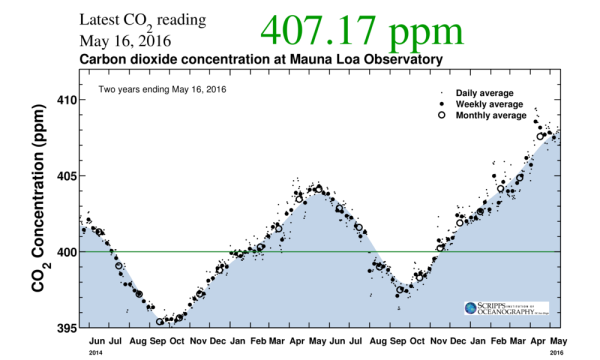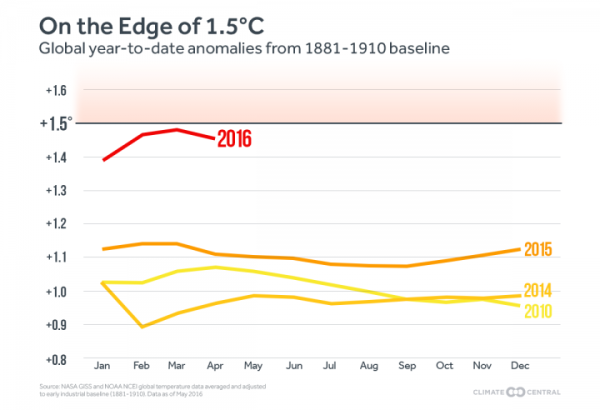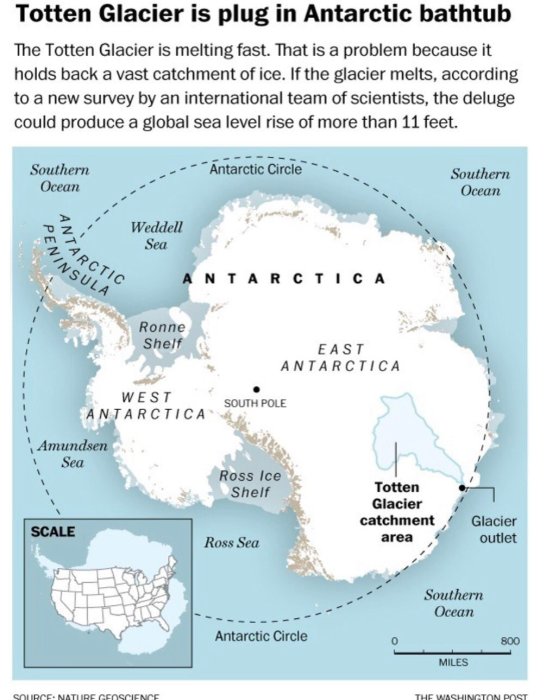Robertscribbler provides the best argument against himself.
Key Hothouse Gas to Rise at Record Rate, Hit Near 408 Parts Per Million in 2016
18
May, 2016
For
2016 it appears that monthly concentrations of atmospheric carbon
dioxide (CO2) will hit a new peak near 408 parts per million at the
Mauna Loa Observatory in April or May. Not only is this the highest
concentration of this key heat-trapping gas ever recorded at Mauna
Loa, but it is also the high water mark of what is likely to be the
most rapid rate of annual CO2 increase ever seen.
(Atmospheric
CO2 keeps being pushed into record ranges by a massive ongoing fossil
fuel emission. Global hothouse gas levels are now high enough to
begin resulting in various catastrophic changes such as rapid sea
level rise, glacial destabilization, increasing instances of
droughts, floods and wildfires, and declining ocean health. Image
source: The
Keeling Curve.)
By
2014, a Century and a half of global fossil fuel burning had dumped
an egregious amount of carbon into the world’s airs — forcing
atmospheric CO2 levels to rise from about 275 parts per million in
the mid 19th Century to a peak of around 401.5 parts per million
during that year.
By May of 2015, atmospheric CO2 levels peaked at around 403.8 parts
per million. And by April of 2016, the monthly average concentrations
of this heat-trapping gas had rocketed to near 407.6 parts per
million. As atmospheric CO2 readings typically peak in May, we can
expect a final top monthly average this year to range between 407.6
to 408 ppm — or 3.8 to 4.2 parts per million higher than during the
same time in 2015. A total overall increase of around 133 parts per
million since the 19th Century. A level of atmospheric carbon that —
if it is maintained — is enough to increase global temperatures by
nearly 3 degrees Celsius over the coming decades and centuries.
(Atmospheric
CO2 levels now approaching 410 parts per million are pushing global
temperatures dangerously close to the 1.5 C threshold identified by
scientists as marking a the first series of civilization-endangering
climate tipping points. Maintaining CO2 levels near 410 parts per
million risks 3 C warming long term. Continuing carbon emissions
makes an already bad situation dramatically worse. Image
source: Climate
Central.)
These
are now the highest atmospheric CO2 levels seen in the last 23
million years. And
an annual rate of CO2 increase approaching 4 parts per million is
unheard of for any time period in any geological record — even
during the Permian hothouse extinction event which wiped out about 90
percent of life in the oceans and 75 percent of life on land. This
very rapid rate of atmospheric CO2 increase is being spurred on by a
fossil fuel based carbon emission now in the range of 13 billion tons
each year (of which CO2 is the vast majority). That’s a rate of
carbon addition more than ten
times faster than the carbon spike that set off the Paleocene-Eocene
hothouse mass extinction about 55 million years ago.
A very dangerous rate of carbon accumulation that will generate
increasingly severe and harmful geophysical changes over the coming
years, decades and centuries. An event that, if it continues, could
well be termed the mother of all carbon spikes.
New
Record Rate of Increase For Hothouse Gas Concentrations as CO2
Emissions Level Off
Peak-to-peak
rates of increase do not capture the full annual average
accumulation, but it is an indicator. And for 2016, it appears the
annual measure will jump by at least 3.5 parts per million. Previous
record rises occurred last year (in 2015) and in 1998 when
atmospheric carbon dioxide jumped by about 3 parts per million. Over
the past decade, carbon dioxide has accumulated by about 2.2 parts
per million each year. So, by any context, 2016 is looking pretty bad
in that we’ll almost certainly see a new record pace of greenhouse
gas accumulation.
(A
recent study in Nature Geoscience found that continued fossil fuel
burning and accumulation of atmospheric greenhouse gasses like carbon
dioxide risks the irreversible destabilization of Totten Glacier
which would result in rapid sea level rise this Century. In total,
the Totten Glacier covers an area the size of the southeastern US, is
more than a mile thick and, if melted, would raise sea levels by 11
feet. Researchers found that the mouth of the Totten Glacier —
holding back this gigantic pile of ice — is rapidly melting now.
Image source: Nature
Geoscience and The
Washington Post.)
The
causes of this amazing and dangerous jump in atmospheric CO2 rest
entirely at the feet of the global fossil fuel industry — which
continues to push through its various political allies and media
agencies for expanded and extended burning of coal, oil, and gas. But
despite numerous attempts by that destructive industry to stifle the
pace of renewable energy adoption and to stymie efforts to increase
energy efficiency, both efficiency and renewables have advanced and
rates of carbon emission leveled off during 2014 and 2015.
What
the industry has achieved, however, is continued delay of a more
rapid rate of renewable energy adoption which has resulted in global
carbon emissions maintaining at current record high ranges. And such
a huge dump of carbon into the atmosphere and oceans would have
inevitably resulted in new record rates of atmospheric CO2 increase
being hit eventually.
(Global
CO2 emissions leveled off in a record range near 32 billion tons per
year during 2014 and 2015. Increasing rates of renewable energy
adoption and improvements in energy efficiency helped to drive this
trend. However, 32 billion tons of CO2 each year [approximately 8
billion tons of the total 13 billion tons of carbon hitting the air
each year when the molecular weight of non-carbon atoms such as
oxygen is removed] is likely the most rapid pace of atmospheric CO2
accumulation in all of the deep history of the Earth. A stark
statistic that lends urgency to rapidly drawing such a high annual
emission rate down. Image source: International
Energy Agency — Decoupling of Global Emissions and Economic Growth
Confirmed.)
This
year, a strong El Nino reduced the ability of oceans to uptake such a
massive volume of pollution belching from the world’s smokestack
and tailpipes. A variable warming of waters that put a lid on what is
an already fading ocean carbon sink. In addition, comparatively small
but significant carbon contributions in the form of increasing global
wildfires, ramping permafrost thaw and burning, and increasing
methane seeps now provide a visible amplifying feedback to the
massive and unprecedented human greenhouse gas emission. A feedback
that is bound to rapidly worsen if the literally insane human fossil
fuel emission does not stop soon.
Links:
Hat
tip to Meteorology
Meg
Hat
tip to DT Lange




No comments:
Post a Comment
Note: only a member of this blog may post a comment.